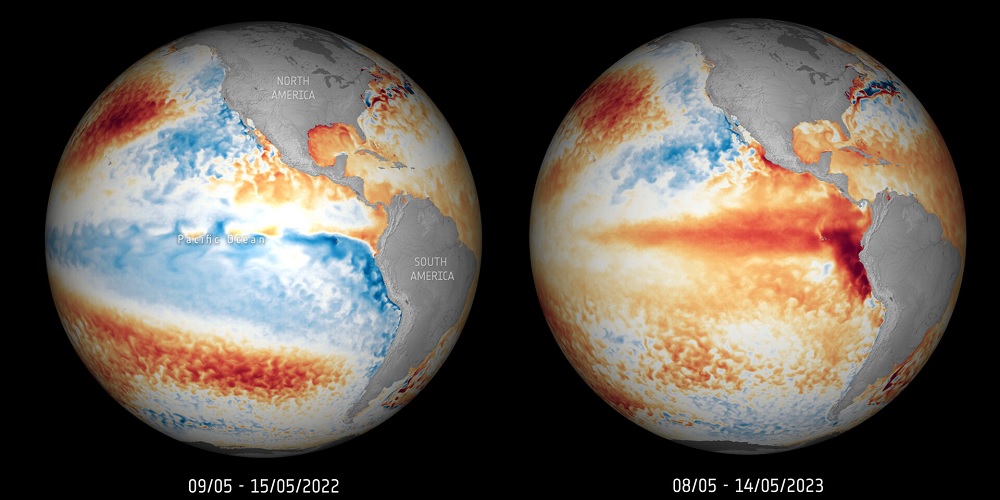User rating: 5 / 5
In addition to the grim list of record ice losses, record air temperatures and record droughts, all of which made headlines recently, the surface water temperature of our oceans has also reached record highs. With an El Niño on the way, it is feared that we will soon see even worse extremes.
Orbiting satellites are being used to closely monitor the patterns leading up to El Niño to better understand and predict the impact of this cyclical phenomenon against the backdrop of climate change. The coupled ocean-atmosphere system of El Niño and La Niña, collectively known as the El Niño Southern Oscillation, is driving significant variations in global temperature and precipitation, in addition to the warming trend due to climate change.
El Niño occurs every few years when the trade winds weaken, shifting warm water in the western Pacific Ocean to the east, causing changes in wind patterns and ocean dynamics. This can have significant impacts on global weather, including changes to ecosystems and fisheries, droughts, floods and storms. According to climate models, after three years of La Niña, which has a general cooling effect on the planet, we will again experience the more problematic El Niño in the coming months.
Climate change has already led to the recent extreme temperatures that many of us have experienced, so the worrying question is whether this looming El Niño will make things worse. Tracking changes in sea surface temperature and elevation, along with the surface wind patterns that result from the interactions between the ocean and the atmosphere, can help us understand the mechanisms that drive El Niño events. In addition, scientists must consider climate change, which is likely to amplify the extremes of these El Niño and future El Niño events. Satellites orbiting above the Earth are paramount to providing the data for this type of research because the tropical Pacific Ocean, where El Niño occurs, is so large that it is difficult to monitor.
Photo: ESA
ESA’s chief scientist, Craig Donlon, said: “More than 70% of our planet is covered by oceans. It plays a huge role in the climate system. “We all know that our climate is warming, but I think most people think first to warmer air temperatures. In fact, our oceans absorbed much of this extra heat, keeping the atmosphere relatively cool. This has taken its toll, and the temperature of our oceans is now at its highest since records began.”
“Scientists around the world use Copernicus Sentinel-3 data, which, together with sea surface height data, provide reference measurements of surface temperature. They also use Copernicus Sentinel-6, which gives us the most accurate measurements of sea surface height. sea surface. When seawater warms, it expands – one of the main causes of sea level rise. These complementary datasets work together to provide a unique picture of the evolving El Niño.”
The Copernicus Sentinel-3 mission, built by ESA and operated by Eumetsat, is unique in providing both global sea surface temperature and sea surface height measurements from the same satellite platform. The mission consists of two identical satellites, each with the same set of instruments – one of which is the Sea and Land Surface Temperature Radiometer, which measures the temperature of the global sea surface every day with an accuracy of better than 0.3 K.
The other is a radar altimeter that measures sea surface height, significant wave height, and wind speed. In addition, the imager, the Ocean and Land Color Imager, allows scientists to study the biological features in the ocean that are altered by El Niño. The Sentinel-3 radiometer is used by the Committee on Earth Observation Satellites as part of its Sea Surface Temperature Virtual Constellation to better understand phenomena such as El Niño and La Niña events, and ocean currents and heat exchange between the ocean and the atmosphere.
Sentinel-6 is the reference altimeter used to homogenize the data from other satellite altimeters and provide sea level rise measurements every ten days. Importantly, the data from both missions is delivered in near real-time. ESA is currently building two other Sentinel-3 satellites, Sentinel-3C and Sentinel-3D, to ensure the continuity of such measurements. Looking to the future, ESA is also developing the follow-up mission Copernicus Sentinel-3 Next Generation.
A second Sentinel-6 satellite is currently in storage and will be launched in the coming years to track sea level data. Since sea surface temperature is an important essential climate variable, ESA’s Climate Change Initiative also provides Sentinel-3 data to its Sea Surface Temperature Project.
The future Copernicus Imaging Microwave Radiometer mission will provide high-resolution measurements of sea surface temperature in all weather conditions. In addition, the Copernicus Land Surface Temperature Monitoring mission will provide very high resolution sea surface temperature data in coastal areas. In short, the Copernicus program is well prepared to continue monitoring our oceans well into the future. Ocean warming is indeed a cause for concern, and with an El Niño imminent, the world is prepared for its consequences. El Niño is likely to affect more than 60 million people, mostly in eastern and southern Africa, the Horn of Africa, Latin America and the Caribbean, and the Asia-Pacific region.
Severe drought and associated food insecurity, flooding, rainfall and temperature increases due to El Niño can cause a wide range of health problems, including disease outbreaks, malnutrition, heat stress and respiratory disease. “Satellites orbiting the Earth now and in the future, not only monitoring our oceans, but also measuring many other aspects of our planet, are more important than ever. They provide hard evidence for science and for decision-making to protect of society,” added Dr. Donlon to it.
Bron: ESA
2023-05-17 17:26:40
#oceans #warm #water #Spacepage

